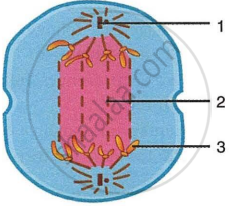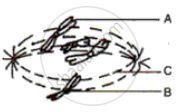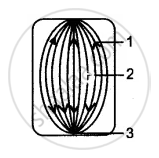Advertisements
Advertisements
प्रश्न
Column ‘II’ is a list of items related to ideas in Column ‘I’. Match the terms in Column ‘II’ with a suitable idea given in Column ‘I’.
| Column I | Column II |
| (i) Anaphase | (a) Chromosomes become arranged in a horizontal plane at the equator. |
| (ii) Prophase | (b) Daughter chromosomes move to opposite poles of the spindle. |
| (iii) Telophase | (c) Chromosomes become visible as fine, long threads. |
| (iv) Metaphase | (d) Chromosomes lose their distinctiveness and gradually become transformed into chromatin network. |
उत्तर
| Column I | Column II |
| (i) Anaphase | (b) Daughter chromosomes move to opposite poles of the spindle. |
| (ii) Prophase | (c) Chromosomes become visible as fine, long threads. |
| (iii) Telophase | (d) Chromosomes lose their distinctiveness and gradually become transformed into chromatin network. |
| (iv) Metaphase | (a) Chromosomes become arranged in a horizontal plane at the equator. |
APPEARS IN
संबंधित प्रश्न
The diagram below represents a stage during cell division. Study the same and then answer the questions that follow:

- Name the parts labelled 1, 2, and 3.
- Identify the above stage and give a reason to support your answer.
- Mention where in the body this type of cell division occurs.
- Name the stage prior to this stage and draw a diagram to represent the same.
Genetic recombination occurs in ______ phase of prophase of meiosis-I.
With the help of suitable diagrams, explain the five stages of prophase-I of meiosis.
The fig given alongside shows a certain stage in a cell division in a cell with four chromosomes.

(i) Name the parts of the chromosome labeled A and B.
(ii) Name the structure C. what is its function?
(iii) Name the type of division . Give a reason.
(iv) Name the stage of division.
(v) Name the stages before and after the stage shown in diagram.
Choose the correct answer:
Which division takes most time?
The diagram below represents a certain stage of a cell.
(i) Is it an animal cell or a plant cell ? Give one reason in support of your answer.
(ii) Label the parts numbered 1 – 3.
(iii) Which stage (phase) of mitosis is represented in this diagram
The figure below shows a certain stage of mitosis:
(i) Name the stage,
(ii) Label the parts 1 to 4
(iii) How many chromosomes are shown here?
Name the following:
The kind of division normally seen at the tip of the root and shoot system.
The phase of karyokinesis which is almost the reverse of prophase is ______.
